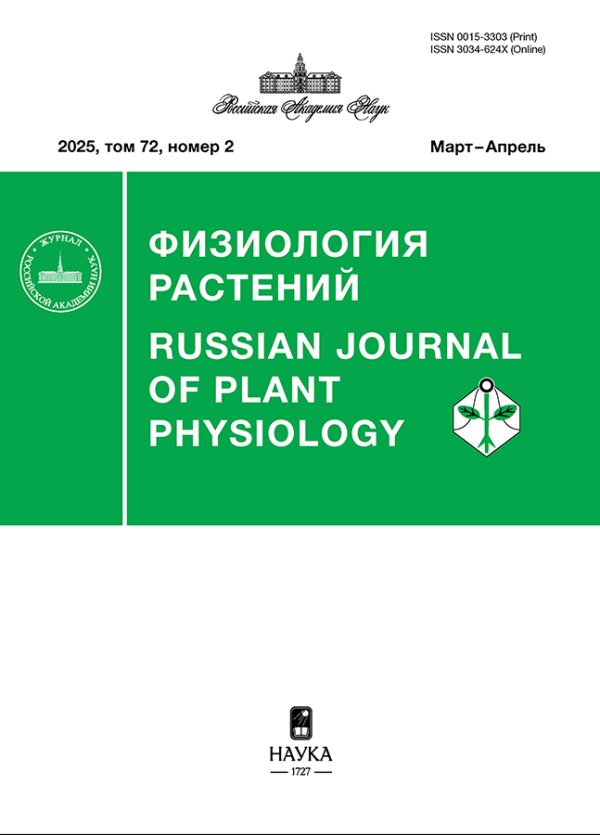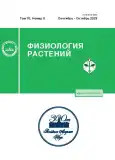Effect of NaCl on the Lipid Profile of Detergent-Resistant membranes of the Chloroplasts and Mitochondria of Euhalophyte Plants
- Authors: Nesterov V.N.1, Bogdanova E.S.1, Rozentsvet O.A.1
-
Affiliations:
- Samara Federal Research Scientific Center RAS, Institute of Ecology of Volga River Basin RAS, Russian Academy of Sciences
- Issue: Vol 70, No 5 (2023)
- Pages: 526-536
- Section: ЭКСПЕРИМЕНТАЛЬНЫЕ СТАТЬИ
- URL: https://journals.rcsi.science/0015-3303/article/view/139788
- DOI: https://doi.org/10.31857/S0015330323600213
- EDN: https://elibrary.ru/WWQCQE
- ID: 139788
Cite item
Full Text
Abstract
The effect of 1 M NaCl on the lipid profile of detergent-resistant chloroplast membranes was studied. sts and mitochondria of salt-accumulating halophyte plants – Salicornia perennans Willd. And Suaeda salsa (L.) Pall. (family Amaranthaceae). The composition of lipids and fatty acids in detergent-resistant membranes differs from the membrane lipids of chloroplasts and mitochondria by a large number of cerebrosides and sterols. Under the given salinity conditions, S. perennans experienced many a fold increase in the proportion of cerebrosides in the composition of detergent-resistant chloroplast membranes, and in S. salsa is found in detergent-resistant mitochondrial membranes. The opposite effect was observed in relation to sterols: a decrease in their relative content under the action of salt. Received data indicate the participation of detergent-resistant membranes in the interaction of chloroplast cells and mitochondria in the cellular response of halophytes to salinity.
About the authors
V. N. Nesterov
Samara Federal Research Scientific Center RAS, Institute of Ecology of Volga River Basin RAS, Russian Academy of Sciences
Email: nesvik1@mail.ru
Russia, Toliaty
E. S. Bogdanova
Samara Federal Research Scientific Center RAS, Institute of Ecology of Volga River Basin RAS, Russian Academy of Sciences
Email: nesvik1@mail.ru
Russia, Tolyatti
O. A. Rozentsvet
Samara Federal Research Scientific Center RAS, Institute of Ecology of Volga River Basin RAS, Russian Academy of Sciences
Author for correspondence.
Email: nesvik1@mail.ru
Russia, Tolyatti
References
- Singer S.J., Nicolson G.L. The fluid mosaic model of the structure of cell membranes // Sci. 1972. V. 175. P. 720. https://doi.org/10.1126/science.175.4023.720
- Nickels J.D., Chatterjee S., Stanley C.B., Qian S., Cheng X., Myles D.A.A., Standaert R.F., Elkins J.G., Katsaras J. The in vivo structure of biological membranes and evidence for lipid domains // PLOS Biol. 2017. V. 15. e2002214. https://doi.org/10.1371/journal.pbio.2002214
- Laloi M., Perret A.-M., Chatre L., Melser S., Cantrel C., Vaultier M.-N., Zachowski A., Bathany K., Schmitter J.-M., Vallet M., Lessire R., Yartmann M.-A., Moreau P. Insights into the role of specific lipids in the formation and delivery of lipid microdomains to the plasma membrane of plant cells // Plant Physiol. 2007. V. 143. P. 461. https://doi.org/10.1104/pp.106.091496
- Hibino H., Kurachi Y. Distinct detergent-resistant membrane microdomains (lipid rafts) respectively harvest K+ and water transport systems in brain astroglia // Eur. J. Neurosci. 2007. V. 26. P. 2539. https://doi.org/10.1111/j.1460-9568.2007.05876.x
- Mongrand S., Stanislas T., Bayer E.M.F., Lherminier J., Simon-Plas F. Membrane rafts in plant cells // Trends Plant Sci. 2010. V. 15. P. 656. https://doi.org/10.1016/j.tplants.2010.09.003
- Lingwood D., Simons K. Lipid rafts as a membrane-organizing principle // Sci. 2010. V. 347. P. 46. https://doi.org/10.1126/science.117462
- Cacas J.-L., Furt F., Le Guédard M., Schmitter J.-M., Buré C., Gerbeau-Pissot P., Moreau P., Bessoule J.-J., Simon-Plas F., Mongrand S. Lipids of plant membrane rafts // Prog. in Lipid Res. 2012. V. 51. P. 272. https://doi.org/10.1016/j.plipres.2012.04.001
- Bessueille L., Sindt N., Guichardant M., Djerbi S., Teeri T.T., Bulone V. Plasma membrane microdomains from hybrid aspen cells are involved in cell wall polysaccharide biosynthesis // Biochem. J. 2009. V. 420. P. 93. https://doi.org/10.1042/bj2008211
- Sun J., Nanjundan M., Pike L.J., Wiedmer T., Sims P.J. Plasma membrane phospholipid scramblase 1 is enriched in lipid rafts and interacts with the epidermal growth factor receptor // Biochem. 2002. V. 41. P. 6338. https://doi.org/10.1021/bi025610l
- Blakeslee J.J., Bandyopadhyay A., Lee O.R., Mravec J., Titapiwatanakun B., Sauer M., Makam S.N., Cheng Y., Bouchard R., Adamec J., Geisler M., Nagashima A., Sakai T., Martinoia E., Friml J., et al. Interactions among PIN-FORMED and P-glycoprotein auxin transporters in Arabidopsis // Plant Cell Online. 2007. V. 19. P. 131. 10.1105/tpc.106.040782' target='_blank'>https://doi.org/doi: 10.1105/tpc.106.040782
- Demira F., Horntricha C., Blachutzika J.O., Scherzera S., Reindersc Y., Kierszniowskaa S., Schulzef W.X., Harmsb G.S., Hedricha R., Geigera D., Kreuzera I. Arabidopsis nanodomain-delimited ABA signaling pathway regulates the anion channel SLAH3 // Proc. Nat. Acad. Sci. 2013. V. 110. P. 8296. 10.1073/pnas.1211667110' target='_blank'>https://doi.org/doi: 10.1073/pnas.1211667110
- Yang H., Richter G.L., Wang X., Młodzińska E., Carraro N., Ma G., Jenness M., Chao D., Peer W.A., Murphy A.S. Sterols and sphingolipids differentially function in trafficking of the Arabidopsis ABCB19 auxin transporter // Plant J. 2012. V. 74. P. 37. https://doi.org/10.1111/tpj.12103
- Ott T. Membrane nanodomains and microdomains in plant – microbe interactions // Cur. Opin. Plant Biol. 2017. V. 40. P. 82. https://doi.org/10.1016/j.pbi.2017.08.008
- Flowers T.J., Glenn E.P., Volkov V. Could vesicular transport of Na+ and Cl– be a feature of salt tolerance in halophytes? // Ann. Bot. 2019. V. 123. P. 1. https://doi.org/10.1093/aob/mcy164
- Ozolina N.V., Kapustina I.S., Gurina V.V., Nurminsky V.N. Role of tonoplast microdomains in plant cell protection against osmotic stress // Planta. 2022. V. 255. P. 65. https://doi.org/10.1007/s00425-021-03800-3
- Bhat R.A., Miklis M., Schmelzer E., Schulze-Lefert P., Panstruga R. Recruitment and interaction dynamics of plant penetration resistance components in a plasma membrane microdomain // Proc. Nat. Acad. Sci. 2005. V. 102. P. 3135. https://doi.org/10.1073/pnas.0500012102
- Nesterov V.N., Nesterkina I.S., Rozentsvet O.A., Ozolina N.V., Salyaev R.K. Detection of lipid-protein microdomains (rafts) and investigation of their functional role in the chloroplast membranes of halophytes // Dokl. Biochem. Biophys. 2017. V. 476. P. 303. https://doi.org/10.1134/S1607672917050040
- Takahashi D., Imai H., Kawamura Y., Uemura M. Lipid profiles of detergent resistant fractions of the plasma membrane in oat and rye in association with cold acclimation and freezing tolerance // Cryobiol. 2016. V. 72. P. 123. https://doi.org/10.1016/j.cryobiol.2016.02.003
- Valitova J.N., Sulkarnayeva A.G., Minibayeva F.V. Plant sterols: diversity, biosynthesis, and physiological function // Biochem. (Moscow). 2016. V. 81. P. 819. https://doi.org/10.1134/S0006297916080046
- Dreyer I., Uozumi N. Potassium channels in plant cells // FEBS J. 2011. V. 278. P. 4293. https://doi.org/10.1111/j.1742-4658.2011.08371.x
- Rahman Md. M., Mostofa M.G., Keya S.S., Siddiqui Md.N., Ansary Md.M.U., Das A.K., Rahman Md.A., Tran L.S.-P. Adaptive mechanisms of halophytes and their potential in improving salinity tolerance in plants // IJMS. 2021. V. 22. P. 10733. https://doi.org/10.3390/ijms221910733
- Shabala S., Mackay A. Ion transport in halophytes // Advan. Bot. Res. 2011. V. 57. P. 151. https://doi.org/10.1016/b978-0-12-387692-8.00005-9
- Trono D., Laus M.N., Soccio M., Pastore D. Transport pathways – proton motive force interrelationship in durum wheat mitochondria // IJMS. 2014. V. 15. P. 8186. https://doi.org/10.3390/ijms15058186
- He C., Berkowitz O., Hu S., Zhao Y., Qian K., Shou H., Whelan J., Wang Y. Co-regulation of mitochondrial and chloroplast function: Molecular components and mechanisms // Plant Commun. 2023. V. 4. P. 1. https://doi.org/10.1016/j.xplc.2022.100496
- Wang Z., Benning C. Chloroplast lipid synthesis and lipid trafficking through ER-plastid membrane contact sites // Biochem. Society Trans. 2012. V. 40. P. 457. https://doi.org/10.1042/BST20110752
- Horvath S.E., Daum G. Lipids of mitochondria // Prog. Lipid Res. 2013. V. 52. P. 590. https://doi.org/10.1016/j.plipres.2013.07.002
- Rozentsvet O., Nesterkina I., Ozolina N., Nesterov V. Detergent-resistant microdomains (lipid rafts) in endomembranes of wild halophytes // Func. Plant Biol. 2019. V. 46. P. 869. https://doi.org/10.1071/FP18263
- Robinson S.P., Downton W.J.S. Potassium, sodium, and chloride content of isolated intact chloroplasts in relation to ionic compartmentation in leaves // Arch. Biochem. Biophys. 1984. V. 228. P. 197. 10.1016/0003-9861(84)90061-4' target='_blank'>https://doi.org/doi: 10.1016/0003-9861(84)90061-4
- Rozentsvet O.A., Nesterov V.N., Sinyutina N.F. The effect of copper ions on the lipid composition of subcellular membranes in Hydrilla verticillata // Chemosphere. 2012. V. 89. P. 108. https://doi.org/10.1016/j.chemosphere.2012.04.034
- Mellgren R.L. Detergent-resistant membrane subfractions containing proteins of plasma membrane, mitochondrial, and internal membrane origins // J. Biochem. Biophys. Meth. 2008. V. 70. P. 1029. https://doi.org/10.1016/j.jbbm.2007.08.001
- Нестеров В.Н., Розенцвет О.А., Богданова Е.С. Влияние абиотических факторов на состав жирных кислот Ulva intestinalis // Сибирский экологических журнал. 2013. № 4. С. 587.
- Розенцвет О.А., Нестеров В.Н., Богданова Е.С. Структурные и физиолого- биохимические аспекты солеустойчивости галофитов // Физиология растений. 2017. Т. 64. С. 251. https://doi.org/10.7868/S001533031704011X
- Lv S., Jiang P., Chen X., Fan P., Wang X., Li Y. Multiple compartmentalization of sodium conferred salt tolerance in Salicornia europaea // Plant Physiol. Biochem. 2012. V. 51. P. 47. https://doi.org/10.1016/j.plaphy.2011.10.015
- Rozentsvet O., Nesterov V., Bogdanova E., Kosobryukhov A., Subova S., Semenova G. Structural and molecular strategy of photosynthetic apparatus organization of wild flora halophytes // Plant Physiol. Biochem. 2018. V. 129. P. 213. https://doi.org/10.1016/j.plaphy.2018.06.006
- Chen M., Cahoon E.B. Plant sphingolipids: structure, synthesis and function // Lipids in photosynthesis: essential and regulatory functions / Eds. Wada H., Murata N., Dordrecht: Springer. 2009. P. 77. https://doi.org/10.1007/978-90-481-28631_5
- Sperling P., Heinz E. Plant sphingolipids: structural diversity, biosynthesis, first genes and functions // Biochim. Biophys. Acta. 2003. V. 1632. P. 1. https://doi.org/10.1016/S1388-1981(03)00033-7
- Jiang Z., Zhou X., Tao M., Yuan F., Liu L., Wu F., Wu X., Xiang Y., Niu Y., Liu F., Li C., Ye R., Byeon B., Xue Y., Zhao H., et al. Plant cell-surface GIPC sphingolipids sense salt to trigger Ca2+ influx // Nature. 2019. V. 572. P. 341. https://doi.org/10.1038/s41586-019-1449-z
- Abbas H.K., Paul R.N., Boyette C.D., Duke S.O., Vesonder R.F. Physiological and ultrastructural effects of fumonisin on jimsonweed leaves // Can. J. Bot. 1992. V. 70. P. 1824. https://doi.org/10.1139/b92-226
- Lindsey K., Pullen M.L., Topping J.F. Importance of plant sterols in pattern formation and hormone signaling // Tren. Plant Sci. 2003. V. 8. P. 521. https://doi.org/10.1016/j.tplants.2003.09.012
- Nieto B., Fores O., Arro M., Ferrer A. Arabidopsis 33hydroxyy33methylglutaryll CoA reductase is regulated at the posttranslational level in response to alterations of the sphingolipid and the sterol biosynthetic pathways // Phytochem. 2009. V. 70. P. 53. https://doi.org/. phytochem.2008.10.010https://doi.org/10.1016/j
Supplementary files













